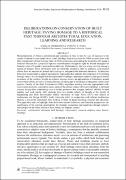| dc.identifier.citation | Ahimbisibwe, A. & Wako, A.K. (2021). Deliberations on Conservation of Built Heritage: Paying Homage to a Historical Past Through Architectural Education, Learning And Research. Structural Studies, Repairs and Maintenance of Heritage Architecture XVII & Earthquake Resistant Engineering Structures XIII, p.29. | en_US |
| dc.description.abstract | Memorialization of Africa’s architectural past continues to fade in time by way of exposure to the cruelty of natural or man-made forces, iconic buildings from as recent as the 1960s are torn down with little consideration of their heritage value. In 2010, controversy surrounding the demolition of Uganda’s National Museum for a proposed high-rise redevelopment brought to light the blatant disregard for thematic value of Uganda’s memorable architecture. Unfortunately, this was a lone survivor among a myriad of projects where developers show no sympathy, architects offer no guidance, and research efforts draw no attention to protect built heritage or safeguard rich historical narratives. Architecture Education should adopt to support participatory approaches that underpin the integration of revitalising heritage values. It is envisaged that through immersive design experiences students could gain a critical awareness of the realities, insight on regional success stories, an appreciation of limitations around conservation efforts, as well as a lasting memory of taking part in the design of integrated conservation projects. Faculty of the Built Environment (FBE), engenders learning activities appropriated with: conservation doctrines, community needs, sense of the cultural context of historic buildings. A pertinent concern during these undertakings was to initiate processes that instigate students’ abilities to band
together and work jointly with: students from two similar schools of thought at the faculty of Engineering and Built Environment (EBE), University of Cape Town (UCT) and School of Architecture and Design (SADE), Ardhi University (AU), in conjunction with African Architecture Matters, a non-profit consultancy firm working in fields of design planning, research and education. This paper thus seeks to highlight, from both socio-cultural inferences and historical perspectives, the significance of the learning opportunities for students, researchers and academics through adaptive reuse project of the oldest cinema in East Africa, the Majestic cinema. | en_US |


